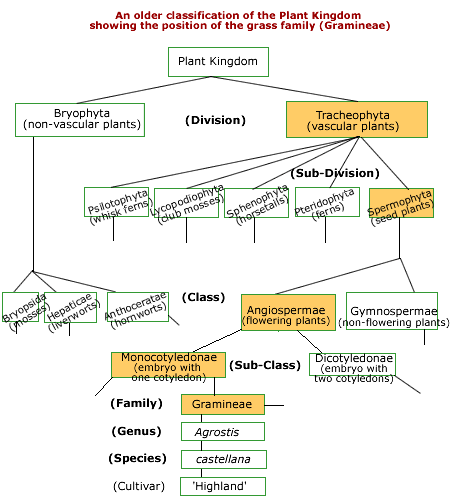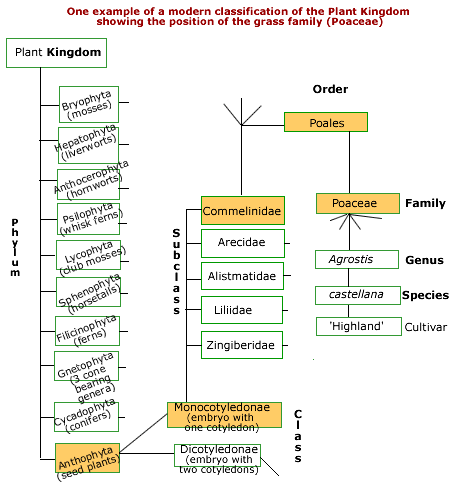Introduction
This article provides the necessary background for understanding plant classification. A particular emphasis will be on where the grass family sits within the whole scheme of a classification system.
To help bring some order and better understanding to the large number of plants (as well as other organisms), especially from a scientific perspective, those individuals that have similar characteristics are grouped together.
To assist in identifying plants with names that can be recognised throughout the world, in contrast to just commonly known names, a system of naming called binomial nomenclature is used.
The current system is based, although significantly modified, on that originally devised by the Swedish botanist, Carolus Linnaeus or Carl von Linné (1707 - 1778).
Binomial Nomenclature
Each plant species can be uniquely identified by this naming convention of using two parts:
- the first part is the generic name (genus),
- whilst the second part is the specific epithet (species).
Plant names are written as follows:
- In Latin, with both parts being italicised.
- The first letter of a genus is capitalised, but that of the specific epithet is not.
- For example Poa annua (i.e. annual meadow grass).
- Cultivated varieties of plants (cultivars) have the first letter of each word capitalised and can be written as follows for the cultivar Highland:
- Agrostis castellana 'Highland' (the preferred form),
- Agrostis castellana cv. Highland,
- Modern cultivars, in addition, are not latinised so as to distinguish them from wild varieties.
For more on Binomial Nomenclature click here
Classification Scheme
The most widely accepted classification system is the Five Kingdoms classification.
- Animalia
- Plantae
- Fungi
- Prokaryotae (Monera/Bacteria)
- Protoctista
Some schemes also include a superkingdom of
- Prokarya (consisting of the Kingdom Prokaryotae);
- Eukarya (consisting of the other 4 Kingdoms).
Taxonomy
This is the study of the classification and naming of living organisms and results in a hierarchy of groups of organisms (known as taxa). A taxon is a taxonomic group, of which there are seven:
- Kingdom
- Phylum (in botany this taxon is still sometimes termed Division)
- Class
- Order
- Family
- Genus
- Species
These taxons are further divided into sub-levels to allow for a more precise classification of the increasing number of identified species. When the taxonomy of plants is being considered then the study is sometimes called systematic botany.
Plant classification and naming of wild species has to be undertaken in accordance with the rules laid down by the International Code of Botanical Nomenclature (ICBN).
Cultivated plants are named in accordance with the International Code of Nomenclature for Cultivated Plants (ICNCP).
Wilson on 'The Diversity of Life' estimates the number of identified species of organisms to be 1.4 million, with the total number of actual species believed to be many more.
The plant kingdom is estimated to contain some 250,000 species, of which the grass family has some 9,000 species.
Old Classification Scheme
An older, but more commonly known classification is that given below:
- The Plant Kingdom is split into 2 Divisions (Phylum);
- The vascular plants are further split into 5 Sub-Divisions;
- The seedbearing plants are split into the Classes of flowering and non-flowering plants;
- The flowering plants are then further split into a Sub-Class of monocots and dicots;
- One of many families in the monocots is the Grass Family, which contains about 9,000 species.
- The example given is that of 'Highland' Browntop Bent.

Modern Classification Scheme
A more modern classification for the plant kingdom is as follows, however, there are a number of variations on this theme alone:
- The Plant Kingdom is split into 10 Phylum;
- The seedbearing plants are split into the Classes of of monocots and dicots;
- The monocots are split into 5 Subclasses;
- The Commelinidae is split into a number of Orders, one of which is the grass order Poales;
- This contains the grass Family, which contains about 9,000 species.
- The example given is that of 'Highland' Browntop Bent.

